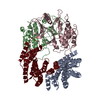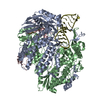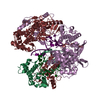+ Open data
Open data
- Basic information
Basic information
| Entry | Database: PDB / ID: 6uan | |||||||||
|---|---|---|---|---|---|---|---|---|---|---|
| Title | B-Raf:14-3-3 complex | |||||||||
 Components Components |
| |||||||||
 Keywords Keywords | SIGNALING PROTEIN / Complex Kinase | |||||||||
| Function / homology |  Function and homology information Function and homology informationCD4-positive, alpha-beta T cell differentiation / CD4-positive or CD8-positive, alpha-beta T cell lineage commitment / negative regulation of synaptic vesicle exocytosis / Signalling to p38 via RIT and RIN / head morphogenesis / myeloid progenitor cell differentiation / ARMS-mediated activation / SHOC2 M1731 mutant abolishes MRAS complex function / Gain-of-function MRAS complexes activate RAF signaling / endothelial cell apoptotic process ...CD4-positive, alpha-beta T cell differentiation / CD4-positive or CD8-positive, alpha-beta T cell lineage commitment / negative regulation of synaptic vesicle exocytosis / Signalling to p38 via RIT and RIN / head morphogenesis / myeloid progenitor cell differentiation / ARMS-mediated activation / SHOC2 M1731 mutant abolishes MRAS complex function / Gain-of-function MRAS complexes activate RAF signaling / endothelial cell apoptotic process / negative regulation of fibroblast migration / positive regulation of D-glucose transmembrane transport / establishment of protein localization to membrane / mitogen-activated protein kinase kinase binding / regulation of T cell differentiation / Negative feedback regulation of MAPK pathway / positive regulation of axonogenesis / Frs2-mediated activation / stress fiber assembly / positive regulation of axon regeneration / face development / MAP kinase kinase activity / synaptic vesicle exocytosis / somatic stem cell population maintenance / thyroid gland development / MAP kinase kinase kinase activity / negative regulation of endothelial cell apoptotic process / positive regulation of substrate adhesion-dependent cell spreading / positive regulation of stress fiber assembly / response to cAMP / ERK1 and ERK2 cascade / cellular response to calcium ion / substrate adhesion-dependent cell spreading / thymus development / cellular response to nerve growth factor stimulus / long-term synaptic potentiation / animal organ morphogenesis / RAF activation / Spry regulation of FGF signaling / Signaling by high-kinase activity BRAF mutants / MAP2K and MAPK activation / epidermal growth factor receptor signaling pathway / visual learning / response to peptide hormone / Negative regulation of MAPK pathway / Signaling by RAF1 mutants / Signaling by moderate kinase activity BRAF mutants / Paradoxical activation of RAF signaling by kinase inactive BRAF / Signaling downstream of RAS mutants / Signaling by BRAF and RAF1 fusions / MAPK cascade / cellular response to xenobiotic stimulus / positive regulation of peptidyl-serine phosphorylation / presynapse / T cell receptor signaling pathway / regulation of cell population proliferation / T cell differentiation in thymus / cell body / scaffold protein binding / negative regulation of neuron apoptotic process / positive regulation of ERK1 and ERK2 cascade / non-specific serine/threonine protein kinase / protein kinase activity / neuron projection / protein phosphorylation / intracellular membrane-bounded organelle / protein serine kinase activity / protein serine/threonine kinase activity / calcium ion binding / protein-containing complex binding / positive regulation of gene expression / negative regulation of apoptotic process / signal transduction / mitochondrion / ATP binding / identical protein binding / nucleus / plasma membrane / cytosol / cytoplasm Similarity search - Function | |||||||||
| Biological species |  Homo sapiens (human) Homo sapiens (human) Spodoptera aff. frugiperda 1 BOLD-2017 (butterflies/moths) Spodoptera aff. frugiperda 1 BOLD-2017 (butterflies/moths) | |||||||||
| Method | ELECTRON MICROSCOPY / single particle reconstruction / cryo EM / Resolution: 3.9 Å | |||||||||
 Authors Authors | Kondo, Y. / Ognjenovic, J. / Banerjee, S. / Karandur, D. / Merk, A. / Kulhanek, K. / Wong, K. / Roose, J.P. / Subramaniam, S. / Kuriyan, J. | |||||||||
| Funding support |  United States, United States,  Canada, 2items Canada, 2items
| |||||||||
 Citation Citation |  Journal: Science / Year: 2019 Journal: Science / Year: 2019Title: Cryo-EM structure of a dimeric B-Raf:14-3-3 complex reveals asymmetry in the active sites of B-Raf kinases. Authors: Yasushi Kondo / Jana Ognjenović / Saikat Banerjee / Deepti Karandur / Alan Merk / Kayla Kulhanek / Kathryn Wong / Jeroen P Roose / Sriram Subramaniam / John Kuriyan /   Abstract: Raf kinases are important cancer drug targets. Paradoxically, many B-Raf inhibitors induce the activation of Raf kinases. Cryo-electron microscopy structural analysis of a phosphorylated B-Raf kinase ...Raf kinases are important cancer drug targets. Paradoxically, many B-Raf inhibitors induce the activation of Raf kinases. Cryo-electron microscopy structural analysis of a phosphorylated B-Raf kinase domain dimer in complex with dimeric 14-3-3, at a resolution of ~3.9 angstroms, shows an asymmetric arrangement in which one kinase is in a canonical "active" conformation. The distal segment of the C-terminal tail of this kinase interacts with, and blocks, the active site of the cognate kinase in this asymmetric arrangement. Deletion of the C-terminal segment reduces Raf activity. The unexpected asymmetric quaternary architecture illustrates how the paradoxical activation of Raf by kinase inhibitors reflects an innate mechanism, with 14-3-3 facilitating inhibition of one kinase while maintaining activity of the other. Conformational modulation of these contacts may provide new opportunities for Raf inhibitor development. #1:  Journal: Science / Year: 2019 Journal: Science / Year: 2019Title: Cryo-EM structure of a dimeric B-Raf:14-3-3 complex reveals asymmetry in the active sites of B-Raf kinases Authors: Kondo, Y. / Ognjenovic, J. / Banerjee, S. / Karandur, D. / Merk, A. / Kulhanek, K. / Wong, K. / Roose, J.P. / Subramaniam, S. / Kuriyan, J. | |||||||||
| History |
|
- Structure visualization
Structure visualization
| Movie |
 Movie viewer Movie viewer |
|---|---|
| Structure viewer | Molecule:  Molmil Molmil Jmol/JSmol Jmol/JSmol |
- Downloads & links
Downloads & links
- Download
Download
| PDBx/mmCIF format |  6uan.cif.gz 6uan.cif.gz | 194.8 KB | Display |  PDBx/mmCIF format PDBx/mmCIF format |
|---|---|---|---|---|
| PDB format |  pdb6uan.ent.gz pdb6uan.ent.gz | 150.1 KB | Display |  PDB format PDB format |
| PDBx/mmJSON format |  6uan.json.gz 6uan.json.gz | Tree view |  PDBx/mmJSON format PDBx/mmJSON format | |
| Others |  Other downloads Other downloads |
-Validation report
| Summary document |  6uan_validation.pdf.gz 6uan_validation.pdf.gz | 855.8 KB | Display |  wwPDB validaton report wwPDB validaton report |
|---|---|---|---|---|
| Full document |  6uan_full_validation.pdf.gz 6uan_full_validation.pdf.gz | 864.9 KB | Display | |
| Data in XML |  6uan_validation.xml.gz 6uan_validation.xml.gz | 35.9 KB | Display | |
| Data in CIF |  6uan_validation.cif.gz 6uan_validation.cif.gz | 54.5 KB | Display | |
| Arichive directory |  https://data.pdbj.org/pub/pdb/validation_reports/ua/6uan https://data.pdbj.org/pub/pdb/validation_reports/ua/6uan ftp://data.pdbj.org/pub/pdb/validation_reports/ua/6uan ftp://data.pdbj.org/pub/pdb/validation_reports/ua/6uan | HTTPS FTP |
-Related structure data
| Related structure data |  20708MC M: map data used to model this data C: citing same article ( |
|---|---|
| Similar structure data | |
| EM raw data |  EMPIAR-10544 (Title: Cryo-EM structure of a dimeric B-Raf:14-3-3 complex reveals asymmetry in the active sites of B-Raf kinases EMPIAR-10544 (Title: Cryo-EM structure of a dimeric B-Raf:14-3-3 complex reveals asymmetry in the active sites of B-Raf kinasesData size: 6.2 TB Data #1: Unaligned multi-frame micrographs of B-Raf:14-3-3 complex [micrographs - multiframe] Data #2: Unaligned multi-frame micrographs of B-Raf:14-3-3 complex [micrographs - multiframe]) |
- Links
Links
- Assembly
Assembly
| Deposited unit | 
|
|---|---|
| 1 |
|
- Components
Components
| #1: Protein | Mass: 28108.514 Da / Num. of mol.: 2 / Source method: isolated from a natural source Source: (natural)  Spodoptera aff. frugiperda 1 BOLD-2017 (butterflies/moths) Spodoptera aff. frugiperda 1 BOLD-2017 (butterflies/moths)References: UniProt: A0A068JLL8 #2: Protein | Mass: 84781.922 Da / Num. of mol.: 2 Source method: isolated from a genetically manipulated source Source: (gene. exp.)  Homo sapiens (human) / Gene: BRAF, BRAF1, RAFB1 Homo sapiens (human) / Gene: BRAF, BRAF1, RAFB1Production host:  Spodoptera aff. frugiperda 1 BOLD-2017 (butterflies/moths) Spodoptera aff. frugiperda 1 BOLD-2017 (butterflies/moths)References: UniProt: P15056, non-specific serine/threonine protein kinase Has ligand of interest | Y | |
|---|
-Experimental details
-Experiment
| Experiment | Method: ELECTRON MICROSCOPY |
|---|---|
| EM experiment | Aggregation state: PARTICLE / 3D reconstruction method: single particle reconstruction |
- Sample preparation
Sample preparation
| Component | Name: Ternary complex of B-Raf kinase domain dimer and 14-3-3 dimer Type: COMPLEX / Entity ID: all / Source: RECOMBINANT | ||||||||||||||||
|---|---|---|---|---|---|---|---|---|---|---|---|---|---|---|---|---|---|
| Molecular weight | Experimental value: NO | ||||||||||||||||
| Source (natural) | Organism:  Homo sapiens (human) Homo sapiens (human) | ||||||||||||||||
| Source (recombinant) | Organism:  Spodoptera aff. frugiperda 1 BOLD-2017 (butterflies/moths) Spodoptera aff. frugiperda 1 BOLD-2017 (butterflies/moths) | ||||||||||||||||
| Buffer solution | pH: 8 | ||||||||||||||||
| Buffer component |
| ||||||||||||||||
| Specimen | Conc.: 0.2 mg/ml / Embedding applied: NO / Shadowing applied: NO / Staining applied: NO / Vitrification applied: YES | ||||||||||||||||
| Specimen support | Grid material: COPPER / Grid mesh size: 200 divisions/in. / Grid type: Quantifoil R1.2/1.3 | ||||||||||||||||
| Vitrification | Instrument: LEICA EM GP / Cryogen name: ETHANE / Humidity: 95 % / Chamber temperature: 278 K |
- Electron microscopy imaging
Electron microscopy imaging
| Experimental equipment |  Model: Titan Krios / Image courtesy: FEI Company |
|---|---|
| Microscopy | Model: FEI TITAN KRIOS |
| Electron gun | Electron source:  FIELD EMISSION GUN / Accelerating voltage: 300 kV / Illumination mode: FLOOD BEAM FIELD EMISSION GUN / Accelerating voltage: 300 kV / Illumination mode: FLOOD BEAM |
| Electron lens | Mode: BRIGHT FIELD |
| Image recording | Electron dose: 50 e/Å2 / Detector mode: SUPER-RESOLUTION / Film or detector model: GATAN K2 SUMMIT (4k x 4k) |
- Processing
Processing
| Software | Name: PHENIX / Version: 1.14_3260: / Classification: refinement | ||||||||||||||||||||||||
|---|---|---|---|---|---|---|---|---|---|---|---|---|---|---|---|---|---|---|---|---|---|---|---|---|---|
| CTF correction | Type: PHASE FLIPPING AND AMPLITUDE CORRECTION | ||||||||||||||||||||||||
| Symmetry | Point symmetry: C1 (asymmetric) | ||||||||||||||||||||||||
| 3D reconstruction | Resolution: 3.9 Å / Resolution method: FSC 0.143 CUT-OFF / Num. of particles: 113313 / Symmetry type: POINT | ||||||||||||||||||||||||
| Refine LS restraints |
|
 Movie
Movie Controller
Controller










 PDBj
PDBj




